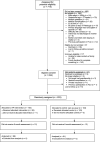Improving Parent-Child Interactions in Pediatric Health Care: A Two-Site Randomized Controlled Trial
- PMID: 33608413
- PMCID: PMC7924140
- DOI: 10.1542/peds.2020-1799
Improving Parent-Child Interactions in Pediatric Health Care: A Two-Site Randomized Controlled Trial
Abstract
Background and objectives: Heterogeneity in risk among low-income families suggests the need for tiered interventions to prevent disparities in school readiness. Smart Beginnings (SB) integrates two interventions: Video Interaction Project (VIP) (birth to 3 years), delivered universally to low-income families in pediatric primary care, and Family Check-Up (6 months to 3 years), targeted home visiting for families with additional family risks. Our objective was to assess initial SB impacts on parent-child activities and interactions at 6 months, reflecting early VIP exposure.
Methods: Two-site randomized controlled trial in New York City (84% Latinx) and Pittsburgh (81% Black), with postpartum enrollment and random assignment to treatment (SB) or control. At 6 months, we assessed parent-child interactions through surveys (StimQ, Parenting Your Baby) and observation (video-recorded play, coded by using Parent-Child Interaction Rating Scales - Infant Adaptation).
Results: A total of 403 families were enrolled at child's birth (201 treatment) with 362 (89.8%) assessed at 6 months. Treatment families had increased StimQ, including total score (Cohen's d = 0.28; P < .001) and domains reflecting reading (d = 0.23; P = .02) and teaching (d = 0.25; P = .01), and Parent-Child Interaction Rating Scales - Infant Adaptation, including a cognitive stimulation factor (d = 0.40; P < .001) and domains reflecting support for cognitive development (d = 0.36; P < .001), and language quantity (0.40; P < .001) and quality (d = 0.37; P < .001). Thus, significant effects emerged across a broad sample by using varied methodologies.
Conclusions: Findings replicate and extend previous VIP findings across samples and assessment methodologies. Examining subsequent assessments will determine impacts and feasibility of the full SB model, including potential additive impacts of Family Check-Up for families at elevated risk.
Trial registration: ClinicalTrials.gov NCT02459327.
Copyright © 2021 by the American Academy of Pediatrics.
Conflict of interest statement
POTENTIAL CONFLICT OF INTEREST: The authors have indicated they have no potential conflicts of interest to disclose.
Figures


Similar articles
-
Primary care strategies for promoting parent-child interactions and school readiness in at-risk families: the Bellevue Project for Early Language, Literacy, and Education Success.Arch Pediatr Adolesc Med. 2011 Jan;165(1):33-41. doi: 10.1001/archpediatrics.2010.254. Arch Pediatr Adolesc Med. 2011. PMID: 21199978 Free PMC article. Clinical Trial.
-
Promoting Cognitive Stimulation in Parents Across Infancy and Toddlerhood: A Randomized Clinical Trial.J Pediatr. 2023 Apr;255:159-165.e4. doi: 10.1016/j.jpeds.2022.11.013. Epub 2022 Dec 5. J Pediatr. 2023. PMID: 36481243 Free PMC article. Clinical Trial.
-
Enhancing Parent Talk, Reading, and Play in Primary Care: Sustained Impacts of the Video Interaction Project.J Pediatr. 2018 Aug;199:49-56.e1. doi: 10.1016/j.jpeds.2018.03.002. Epub 2018 Apr 24. J Pediatr. 2018. PMID: 29703577 Free PMC article. Clinical Trial.
-
Reducing Poverty-Related Disparities in Child Development and School Readiness: The Smart Beginnings Tiered Prevention Strategy that Combines Pediatric Primary Care with Home Visiting.Clin Child Fam Psychol Rev. 2021 Dec;24(4):669-683. doi: 10.1007/s10567-021-00366-0. Epub 2021 Sep 9. Clin Child Fam Psychol Rev. 2021. PMID: 34505232 Free PMC article. Review.
-
Potential of 'stacking' early childhood interventions to reduce inequities in learning outcomes.J Epidemiol Community Health. 2019 Dec;73(12):1078-1086. doi: 10.1136/jech-2019-212282. Epub 2019 Oct 5. J Epidemiol Community Health. 2019. PMID: 31586934 Review.
Cited by
-
Smart Beginnings Predicts Reduced Externalizing Behavior Via Parental Negative Demeanor During Discipline.J Appl Dev Psychol. 2025 May-Jun;98:101796. doi: 10.1016/j.appdev.2025.101796. Epub 2025 Apr 23. J Appl Dev Psychol. 2025. PMID: 40330905
-
Pediatric Primary Care and Partnerships Across Sectors to Promote Early Child Development.Acad Pediatr. 2021 Mar;21(2):228-235. doi: 10.1016/j.acap.2020.12.002. Epub 2020 Dec 19. Acad Pediatr. 2021. PMID: 33352322 Free PMC article.
-
Maternal perceived safety and parenting practices with young children: a cross-sectional analysis from 15 low-income and middle-income countries.BMJ Public Health. 2024 Oct 9;2(2):e000461. doi: 10.1136/bmjph-2023-000461. eCollection 2024 Dec. BMJ Public Health. 2024. PMID: 40018551 Free PMC article.
-
Housing Insecurity, Housing Conditions, and Breastfeeding Behaviors for Medicaid-Eligible Families in Urban Settings.J Hum Lact. 2022 Nov;38(4):760-770. doi: 10.1177/08903344221108073. Epub 2022 Jul 1. J Hum Lact. 2022. PMID: 35775199 Free PMC article. Clinical Trial.
-
Impacts of a tiered intervention on child internalizing and externalizing behavior in the context of maternal depression.Dev Psychopathol. 2025 Feb;37(1):136-146. doi: 10.1017/S0954579423001475. Epub 2023 Dec 14. Dev Psychopathol. 2025. PMID: 38093598 Free PMC article. Clinical Trial.
References
-
- Council on Community Pediatrics . Poverty and child health in the United States. Pediatrics. 2016;137(4):e20160339. - PubMed
-
- Mendelsohn AL, Cates CB, Weisleder A, Berkule SB, Dreyer BP. Promotion of early school readiness using pediatric primary care as an innovative platform. Zero Three. 2013;34(1):29–40
-
- High PC, Klass P; Council on Early Childhood . Literacy promotion: an essential component of primary care pediatric practice. Pediatrics. 2014;134(2):404–409 - PubMed
-
- Love JM, Kisker EE, Ross C, et al. . The effectiveness of Early Head Start for 3-year-old children and their parents: lessons for policy and programs. Dev Psychol. 2005;41(6):885–901 - PubMed
-
- Jimenez ME, Barg FK, Guevara JP, Gerdes M, Fiks AG. Barriers to evaluation for early intervention services: parent and early intervention employee perspectives. Acad Pediatr. 2012;12(6):551–557 - PubMed
Publication types
MeSH terms
Associated data
Grants and funding
LinkOut - more resources
Full Text Sources
Other Literature Sources
Medical

